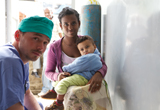 “Can I ask your advice doctor?” The recovery nurse who I had been teaching looked puzzled. “I have been asked by some of my colleagues on the wards how to wake up patients who have not recovered from their anaesthetic after one or two days. What do you suggest?”
“Can I ask your advice doctor?” The recovery nurse who I had been teaching looked puzzled. “I have been asked by some of my colleagues on the wards how to wake up patients who have not recovered from their anaesthetic after one or two days. What do you suggest?”
My heart sank; all of the drugs we were using for anaesthesia should have cleared within hours, and a patient who was still asleep after two days was more likely to have suffered some other untoward event. After a few months of working in Ethiopia, I had a near certain guess as to the cause.
Post-operative hypoxia is well-recognised. Hypoventilation as a result of residual anaesthesia causes a hypoxic mixture in the alveolus, especially while breathing the thin room air of Addis Ababa, which lies at 2500 meters above sea level. A patient discharged to the recovery ward whilst not fully awake is easily capable of becoming hypoxic within minutes.
In the UK this would be quickly recognised by recovery nurses and anaesthetists due to pulse oximetry monitoring, and it would be treated with high-flow oxygen and simple airway manoeuvres—a simple and life-saving intervention. However, where pulse oximetry is not available, hypoxia can go unnoticed and untreated, causing irreversible cerebral hypoxic damage. These unlucky patients don’t wake up so well.
Working as a Voluntary Service Overseas (VSO) anaesthetist in Ethiopia I spent ten months in a large hospital in Addis Ababa. It became clear that there were huge safety gains to be made through the application of simple technologies, such as pulse oximetry, so long as the nurses could be trained to use the equipment. I was confident I could provide the training, and cylinder oxygen was available, so my challenge was to source the pulse oximeters.
Yekatit 12 Hospital, where I worked, supports a catchment population of around 5 million people and performs around 4000 operations each year. However, its annual operating budget is around £2.5 million, around 1% of that of a district general hospital in the UK that might serve 750,000 people. When you look at figures like this, you can see why obtaining pulse oximeters might be a challenge.
The Lifebox Foundation works to improve surgical safety in low resource areas and through them I was able to obtain 12 pulse oximeters during my time in Ethiopia. These robust, reliable, and affordable units provided continuous monitoring for all patients in our recovery unit, as well as a new four bedded surgical high dependency unit which we established. Along with other low cost interventions, such as the WHO Safe Surgery Checklist, we were able to make a tangible difference to our patients’ outcomes.
Mortality and morbidity as a result of surgery and anaesthesia remain unacceptably high in many parts of the world. Lifebox aim to improve the safety of some of the most vulnerable people on the planet, but the task is enormous. Our work in Ethiopia was only possible due to your support. Thank you.
For more information about Lifebox, or to donate, see this week’s BMJ or visit www.lifebox.org. The BMJ campaign runs until the end of January.
Tom Bashford is an anaesthetics and intensive care trainee from London. He volunteered with VSO as an anaesthetist in Ethiopia between 2011 and 2012 before returning to London to complete his core training. He qualified from St Georges Hospital Medical School in 2007.
Photo credit: VSO/Ben Langdon.
